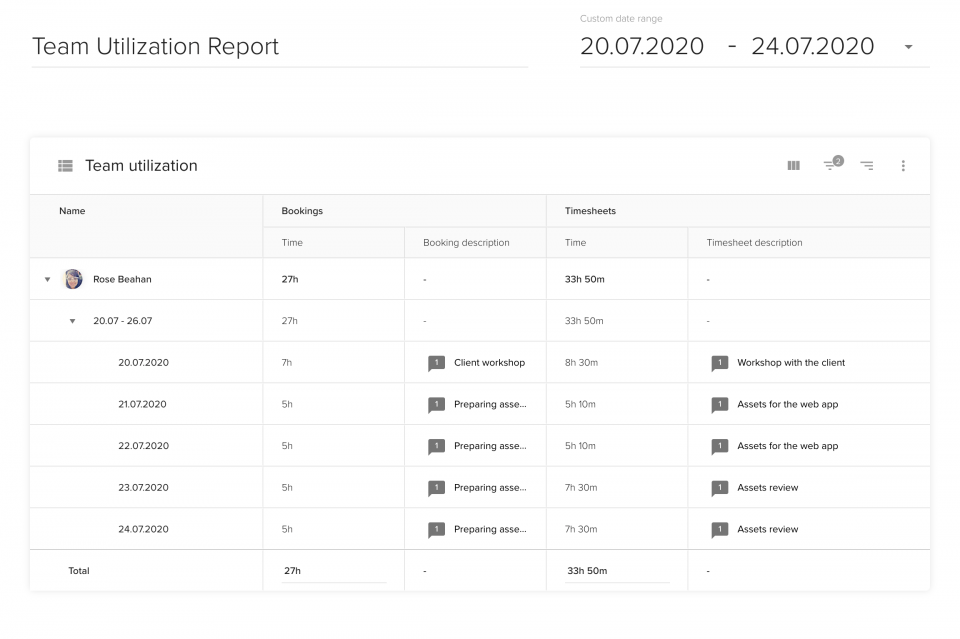资源日历--用一个工具管理整个团队
资源日历(或项目管理日历、或项目规划日历、资源规划软件)可让您更有效、更高效地规划、管理和分配资源--尤其是如果 Microsoft Excel 在您的项目中发挥了主导作用。
加班,即超出计划的工作量,是一个非常复杂的问题,不能简单地提出 "不惜一切代价避免 "的建议。 事实上,在出现意想不到的复杂情况时,加班加点可能是挽救项目的唯一办法。
您不希望加班成为家常便饭,因为这会对公司的财务和文化造成损害。 幸运的是,有一些行之有效的做法可以帮助您合理地管理加班时间。在本文中,我们将逐一介绍。
感谢您阅读本文:
高效的加班管理(和 时间管理策略) 首先要规划一个平衡的工作时间表。这是您可能犯下代价高昂的错误的地方,这些错误将在整个项目中成倍增加。如何避免?在可能的情况下,尝试 灵活规划允许有其他方案和时间调整。

您可能还需要分析所有员工的计划工作量:要格外关注那些拥有独特技能的员工,因为他们的任务无法转移给其他团队成员。如果他们的工作量很大,加班就更有可能发生,因为没有其他人可以帮忙。

避免出现这种情况的一个办法是建立一个自由职业者网络,在需要时将他们纳入项目。另一个办法是雇佣一个拥有类似技能的新人,让他承担部分工作。 朝九晚五,提高生产力
监测工作量虽然是一个必要步骤,但并非总能避免加班。时间紧迫、期限不可更改的项目,一旦出现问题,回旋的余地就很小。
员工生病或出现技术问题,都会很快导致团队不得不加班加点。为了尽量减少加班,你可以实施一些规则,帮助大家专注于朝九晚五的工作。
首先,你要确保你的团队知道他们即将面临的任务是什么。这听起来很明显,但并不总是如此。不知道自己任务(或不完全了解任务范围)的团队成员很可能会在开始工作前损失大量宝贵时间。

下一步是减少任何非必要的会议。如果您采用敏捷方法进行项目管理,您可以安排 Scrum会议.它们旨在涵盖基本要点,不浪费时间和资源。
提高效率的另一种方法是促进团队成员之间的交流。市场上有很多协作工具:从聊天应用程序(如......)到......。 松弛)到项目管理软件(如 JIRA).
选择好工具后,尝试将它们相互集成,以创建流畅的工作流程。例如,在 Slack 上安装 JIRA 通知:这样团队成员就能实时看到更新并做出相应的反应。

项目启动后,您需要跟踪可交付成果的进度和实际工作量(了解更多内容 工作量管理).如何做到这一点?了解员工工作时间的有效方法是使用时间跟踪软件。这实际上也方便了团队。

有了考勤表,您的团队成员就能确保您看到他们付出的额外努力。对管理人员来说,这样做的好处是什么?您越早了解加班情况,就能越快找到根本原因。
为了有效地监控团队的工时表,最好使用自动更新功能。 时间表报告.在查看跟踪的时间数据时,分析时间表的描述也很有用。说明是员工在记录特定时间条目时可以输入的注释。查看说明可以让你对团队的加班模式有宝贵的了解:

从上图中可以看出,Rose 只有在需要与客户互动的任务(研讨会、资产审查)中才会记录大量的加班时间。也许这值得研究一下?
根据超时的原因,您可以调整项目计划(了解更多信息 项目调度技术)或增加额外的帮手。如果你认为有些加班是不可能避免的,一定要向团队传达你的期望。
虽然许多员工都愿意加班加点,但他们的加班导致了工作与生活的不平衡。因此,大多数公司都会为正常工作时间之外的时间支付额外费用。由于所有费用都应包含在项目预算中(了解更多信息 项目预算跟踪)了解加班补偿的金额非常重要。

一些 资源管理工具 通过提供报告,您可以从 时间表.在 Teamdeck 中,您可以创建自动更新的薪酬报告,帮助您管理加班时间。
只需选择所需的数据点,然后输入团队的加班费率即可。您可以对不同的团队成员使用不同的费率。随着项目的进行,你只需打开报告,查看当前的加班费用。您甚至可以与薪资团队共享报告链接,让他们的工作更轻松。
